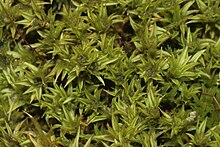Marsh whiskered moss
| Marsh whiskered moss | ||||||||||||
|---|---|---|---|---|---|---|---|---|---|---|---|---|

Marsh whiskered moss ( Barbula crocea ) |
||||||||||||
| Systematics | ||||||||||||
|
||||||||||||
| Scientific name | ||||||||||||
| Barbula crocea | ||||||||||||
| ( Brid. ) F. Weber & Mohr |
The marsh beard moss ( Barbula crocea , Syn. : Barbula paludosa . Web & Mohr) is a moss -Art from the family pottiaceae .
features
The marsh mustache moss forms dense lawns that are yellow-green on top and tanned on the inside. The 1 to 6 (maximum 10) centimeter high stems are not very branched and rhizoid-tomentose in the lower part . The leaves are upright when moist, twisted or twisted when dry. They are lanceolate and pointed. The leaf margins are wavy, flat or slightly bent back below and irregularly and remotely serrated towards the tip of the leaf. The leaf vein extends to the tip of the leaf or, less often, can emerge briefly. The top of the ribs has elongated cells. The leaf cells are round and square in the upper part of the leaf, about 6 to 9 µm in size and densely papillary; at the leaf base they are narrow, rectangular and smooth.
In the leaf axils there are mostly characteristic, relatively large, ellipsoidal, stalked and multicellular breeding bodies for this species .
The sporophytes have a red seta and a narrow, elongated egg-shaped to ellipsoidal capsule with a long beaked lid and long, 3 to 4 times left-wound peristome teeth . The spores are smooth, yellowish and 9 to 12 µm in size. The plants are diocesan .
Occurrence
The moss grows on fresh to moist, sometimes trickled limestone rocks and tufa in shady to light-rich, humid locations. It occurs in the European mountains (Alps and Alpine foothills, Jura, Pyrenees, very rarely Scandinavia). Outside of Europe, it was observed in Algeria.
literature
- Ruprecht Düll , Barbara Düll-Wunder: Determine mosses easily and reliably. An illustrated excursion guide to the types of Germany and neighboring countries. Quelle & Meyer, Wiebelsheim 2008, ISBN 978-3-494-01427-2 .
- Jan-Peter Frahm , Wolfgang Frey : Moosflora (= UTB . 1250). 4th, revised and expanded edition. Ulmer, Stuttgart 2004, ISBN 3-8252-1250-5 .
- Martin Nebel, Georg Philippi (ed.): The mosses of Baden-Württemberg. Volume 1: General part, special part (Bryophytina I, Andreaeales to Funariales). Ulmer, Stuttgart 2000, ISBN 3-8001-3527-2 .
